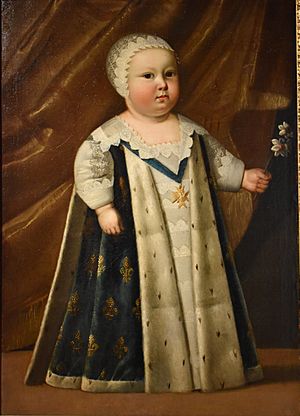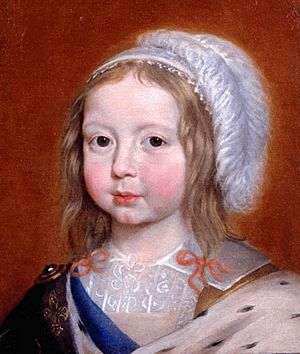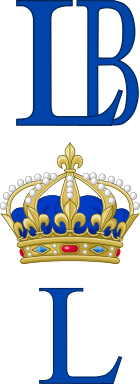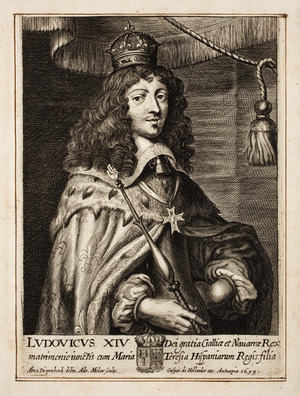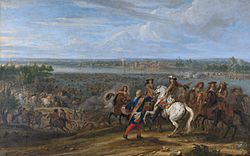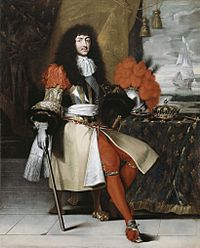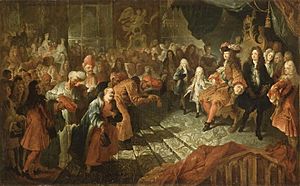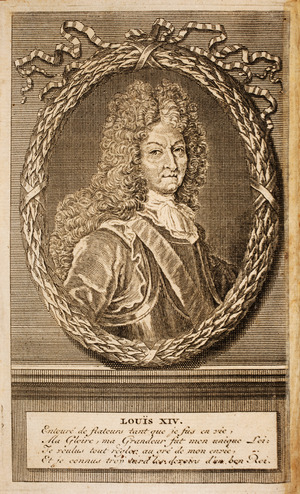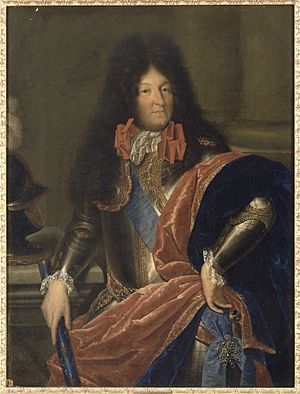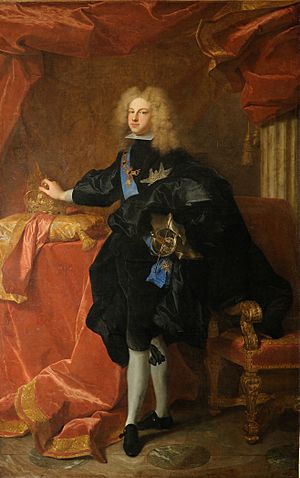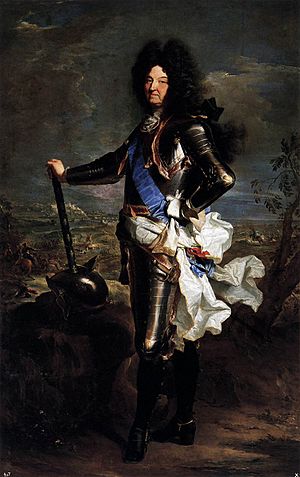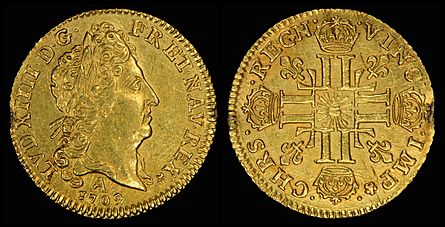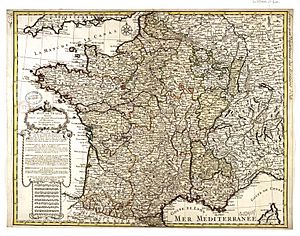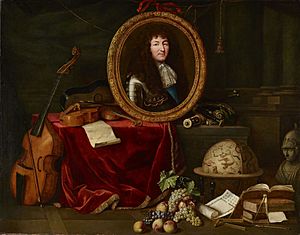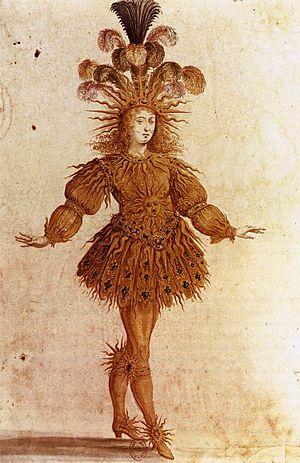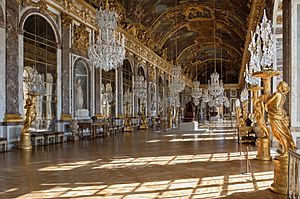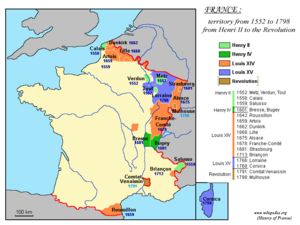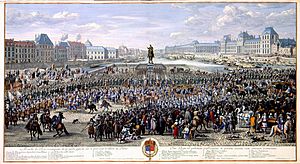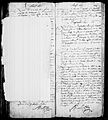Louis XIV facts for kids
Quick facts for kids Louis XIV |
|||||
|---|---|---|---|---|---|
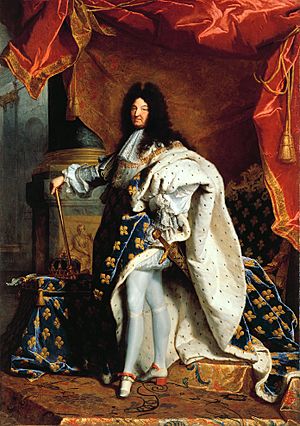
Portrait of Louis XIV by Hyacinthe Rigaud, c. 1701
|
|||||
| King of France (more...) | |||||
| Reign | 14 May 1643 – 1 September 1715 | ||||
| Coronation | 7 June 1654 Reims Cathedral |
||||
| Predecessor | Louis XIII | ||||
| Successor | Louis XV | ||||
| Regent | Anne of Austria (1643–1651) | ||||
| Chief ministers |
See list
|
||||
| Born | 5 September 1638 Château de Saint-Germain-en-Laye, Saint-Germain-en-Laye, France |
||||
| Died | 1 September 1715 (aged 76) Palace of Versailles, Versailles, France |
||||
| Burial | 9 September 1715 Basilica of Saint-Denis |
||||
| Spouse |
|
||||
| Issue among others... |
Illegitimate:
|
||||
|
|||||
| House | Bourbon | ||||
| Father | Louis XIII | ||||
| Mother | Anne of Austria | ||||
| Religion | Catholicism (Gallican Rite) | ||||
| Signature |  |
||||
Louis XIV (born 5 September 1638, died 1 September 1715) was a very important King of France. He was also known as Louis the Great or the Sun King. He ruled for 72 years, from 1643 until his death in 1715. This was the longest reign of any king in history that we know for sure.
Louis XIV's time was known as the Age of Absolutism in Europe. This means kings had almost complete power. He worked with many talented people like Cardinal Mazarin, Jean-Baptiste Colbert, and Molière.
Louis started to rule France by himself in 1661, after his chief minister, Cardinal Mazarin, died. He believed in the divine right of kings, which meant he thought his power came directly from God. He wanted to make France a strong, centralized country, ruled from the capital. He also tried to get rid of old feudal ways. He made many nobles live at his amazing Palace of Versailles. This helped him control them, especially after some nobles rebelled when he was younger.
He made the Catholic Church the only accepted religion in France. He took away the rights of Huguenots, who were Protestants. Many Protestants had to leave France or change their religion.
During Louis's long rule, France became the strongest country in Europe. France fought in many big wars against other powerful countries. These wars included the Franco-Dutch War, the Nine Years' War, and the War of the Spanish Succession. Louis believed that war was a way to show France's power and glory.
Some of his greatest achievements were building the Canal du Midi, supporting many artists, and starting the French Academy of Sciences.
Contents
- Early Life of Louis XIV
- Becoming King and Facing Challenges
- Louis XIV's Personal Rule and Changes
- Early Wars and Foreign Relations
- Louis XIV's Power and Control
- Religious Changes: The Edict of Fontainebleau
- The Nine Years' War
- The War of the Spanish Succession
- Louis XIV's Personal Life
- How Louis XIV Was Seen
- Health and Death of Louis XIV
- Louis XIV's Legacy
- Royal Symbols
- Order of Saint Louis
- Family
- Images for kids
- See also
Early Life of Louis XIV
Louis XIV was born on 5 September 1638, at the Château de Saint-Germain-en-Laye. His parents were Louis XIII and Anne of Austria. He was called Louis Dieudonné, meaning "Louis the God-given." People thought his birth was a miracle because his parents had been married for 23 years and his mother had lost four babies before him.
Louis had a very loving relationship with his mother. They both enjoyed food and theater. His mother taught him to believe that a king's power was absolute and came from God.
When he was a child, Nicolas V de Villeroy became his tutor. Louis became good friends with Villeroy's children.
Becoming King and Facing Challenges
How Louis Became King
Louis XIII, Louis XIV's father, was very sick in 1643. He decided that a group of people, called a regency council, should rule for his son. He didn't think Queen Anne could rule alone.
But after Louis XIII died on 14 May 1643, Queen Anne went to the Parlement de Paris (a powerful court). She got her husband's will changed. This made her the only Regent of France. She chose Cardinal Mazarin as her chief minister. Anne wanted her son to have absolute power and a successful kingdom.
Anne made sure that France's interests came first. She kept Pierre Séguier, a minister who had once treated her badly, in his job. This showed she was focused on France and her son.
In 1648, Anne and Mazarin helped negotiate the Peace of Westphalia. This treaty ended the Thirty Years' War. France gained a lot from this peace, including new lands like Alsace.
The Fronde Rebellion
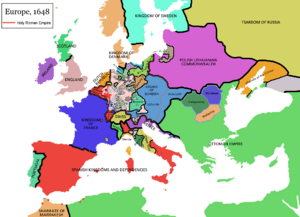
As the Thirty Years' War ended, a civil war called the Fronde started in France. It was named after slings used to break windows. This war stopped France from fully benefiting from the peace treaty. Anne and Mazarin had been making the King's power stronger, which upset the nobles and the Parlements.
Queen Anne was very proud and believed strongly in the King's divine rights. She wanted to give her son complete power over money and justice. She even jailed nobles and members of the Parlement who challenged her.
The Frondeurs (the rebels) wanted to keep their old feudal rights. They felt their power was being taken away by new government officials.
In 1648, Anne and Mazarin tried to tax the Parlement de Paris. They refused and burned the King's old tax laws. After a French military victory, Mazarin, at Anne's urging, arrested some members. The most important was Pierre Broussel.

People in Paris rioted, and Anne had to free Broussel. On 9–10 February 1651, a mob broke into the royal palace. They demanded to see the King. Louis, who was 12, pretended to be asleep, and the crowd left. This threat made Anne and the King flee Paris.
Later, the army returned to help. They attacked the rebels in Paris. After some fighting, a peace deal was made, and the court returned to Paris.
However, the peace didn't last. Mazarin was unpopular, and a new group of nobles formed a coalition. They freed the arrested princes, sent Mazarin into exile, and put Queen Anne under house arrest.
Louis saw all these events. They made him distrust Paris and the powerful nobles. His childhood became insecure. The royal family had to leave Paris twice. These years made Louis hate Paris and decide to move the capital as soon as he could.
The Fronde ended in 1653 when Mazarin returned. From then on, Mazarin managed foreign and financial matters without Anne's daily oversight.
During this time, Louis fell in love with Mazarin's niece, Marie Mancini. But Anne and Mazarin stopped the relationship. Anne wanted Louis to marry the daughter of her brother, Philip IV of Spain. This marriage was important for peace with Spain and for France's future claims to the Spanish throne. Louis was very sad, but his mother did not change her mind.
Louis XIV's Personal Rule and Changes
Taking Control and Making Reforms
Louis XIV was declared an adult on 7 September 1651. When Cardinal Mazarin died in March 1661, Louis surprised everyone. He announced he would rule without a chief minister. He told his secretaries and ministers that he would govern everything himself.
Louis took advantage of the public's desire for order after years of war and civil unrest. He made the King's power even stronger. He chose talented people to help him. The historian Chateaubriand said that "the voice of genius of all kinds" came from Louis's time.
Louis started his rule by fixing the government's money problems. In 1661, the treasury was almost empty. He chose Jean-Baptiste Colbert as his finance minister in 1665. First, Louis had to deal with Nicolas Fouquet, the previous finance chief. Fouquet had built a very fancy castle and seemed richer than the King. People thought he was stealing government money.
Fouquet was found guilty and sentenced to exile. But Louis changed it to life in prison and got rid of Fouquet's job.
Colbert then worked to reduce the national debt by making taxes more efficient. He made officials keep proper records and reduced some taxes. The government's money situation improved greatly. The deficit turned into a surplus by 1666.
To pay for his large army, the Palace of Versailles, and the growing government, the King needed a lot of money. The old tax system was unfair. Only the "unprivileged" classes, mostly peasants, paid direct taxes. Nobles were exempt. Later in his reign, Louis did manage to tax nobles for the first time in French history, but many found ways to get exemptions.
Louis and Colbert also wanted to boost French trade. Colbert started new industries and encouraged inventors. He invited skilled workers from all over Europe to France. His goal was to buy less from other countries and sell more French goods.
Louis also improved the army with the help of Michel le Tellier and his son François-Michel le Tellier, Marquis de Louvois. They made the army more professional and disciplined. The old noble generals no longer had all the power. Louvois focused on the soldiers' well-being and training.
Rules for the Kingdom and Colonies
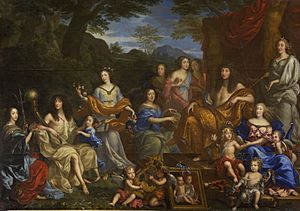
Louis also paid attention to legal matters. He created new laws, like the Code Louis in 1667. This code tried to make laws more uniform across France. It also required births, marriages, and deaths to be recorded by the state, not just the church. This code later influenced the Napoleonic Code.
Louis also issued the Grande Ordonnance sur les Colonies in 1685, also known as the Code Noir. This set rules for the French colonies.
Louis ruled through several councils, like the High Council for important state matters, and the Royal Council of Finances.
Early Wars and Foreign Relations
Conflicts with Spain
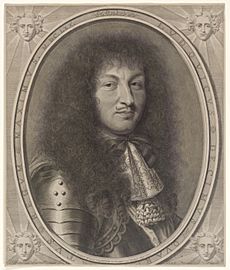
When his uncle, Philip IV of Spain, died in 1665, it led to the War of Devolution. Louis had married Philip IV's oldest daughter, Maria Theresa, in 1660. As part of their marriage treaty, Maria Theresa gave up her claims to Spanish lands. However, this was only if Spain paid a large dowry, which they never did.
Louis used this unpaid dowry as a reason to say Maria Theresa's claims were still valid. He argued that some Spanish lands should "devolve" (pass) to his wife. This gave France a reason to attack the Spanish Netherlands.
Relations with the Dutch Republic
France had supported the Dutch Republic against Spain in the past. But Louis's expansion into the Spanish Netherlands threatened Dutch trade.
The Dutch formed an alliance with England and Sweden against France. This made Louis give up some of his gains in the 1668 Treaty of Aix-la-Chapelle.
Louis then decided to defeat the Dutch Republic first. He paid Sweden to stay neutral and made a secret alliance with England in 1670. In May 1672, France invaded the Dutch Republic.
The quick French advance led to a change in Dutch leadership. William III came to power. Other European countries, like the Holy Roman Empire and Spain, saw France's expansion as a threat. They formed an alliance against France.
England left the war in 1674. French armies still had advantages, like strong generals and good supplies. They held their ground and retook some areas. By 1678, everyone was tired of fighting. The Treaty of Nijmegen was signed, which mostly favored France.
Louis was at the peak of his power. But his actions made other countries unite against him. He continued to expand France's borders, using legal arguments to claim new territories. He took cities like Luxembourg and Strasbourg in 1681.
Spain declared war, but they were quickly defeated. By 1684, Spain had to agree to France occupying most of the conquered lands for 20 years.
Louis's policies made France larger and more powerful. But they also made many European countries wary of him. France gained a reputation for being harsh. Many states stopped being allies with France. By the late 1680s, France was becoming isolated in Europe.
French Colonies and Global Connections
French colonies grew in Africa, the Americas, and Asia during Louis's reign. French explorers made important discoveries in North America. In 1673, Louis Jolliet and Jacques Marquette discovered the Mississippi River. In 1682, René-Robert Cavelier, Sieur de La Salle, claimed the vast Mississippi basin for France, naming it Louisiane.
France also set up trading posts in India and the Indian Ocean. Louis and Colbert started building projects in these colonies to reflect French style and power.
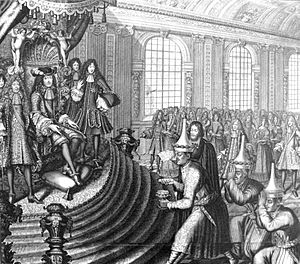
Louis also started diplomatic relations with distant countries. He received ambassadors from the Ottoman Empire, Morocco, and Persia.
Siam (now Thailand) sent an embassy in 1684. Louis sent his own embassy in return. French influence grew in Siam for a while. France also tried to be active in Jesuit missions to China. Louis sent Jesuit missionaries to the Kangxi Emperor's court in 1685.
Louis XIV's Power and Control
Strengthening Royal Power
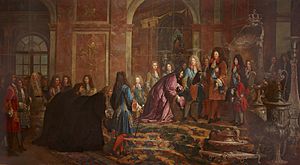
By the early 1680s, Louis had greatly increased France's influence. At home, he made the King's power stronger over the church and the nobles. This helped create an absolute monarchy in France.
Louis supported the idea of Gallicanism, which limited the Pope's power in France. He called a meeting of French clergy in 1681. This meeting agreed to increase the King's power over the church. For example, bishops needed royal approval to leave France.
Louis controlled the nobles by making them live at his court in Versailles. The palace became a place for marriages, jobs, and entertainment. It had the best theater, opera, music, and hunting.
Apartments were built for nobles who wanted to be at court. But to live in style, they had to constantly attend to Louis. An elaborate court ritual was created. The King was the center of attention all day. Louis had a good memory and could see who was present and who was not. This helped him decide who got favors and positions.
Louis also used censorship to control his nobles. He would open letters to see what people thought of the government. By entertaining and impressing them with luxury, Louis kept the nobles busy and under his watch.
Louis's grand spending at Versailles was huge. He even received an African elephant as a gift. He encouraged nobles to live at Versailles. This, along with banning private armies, stopped them from spending time on their own lands. This is where they used to fight local wars and plan against the King.
Louis made the old military nobles (the "nobility of the sword") into ceremonial courtiers. This weakened their power. Instead, he promoted commoners or newer nobles (the "nobility of the robe") to important government jobs. He believed these men could be dismissed more easily than old, powerful nobles. Louis's policies helped end major civil wars in France for about a century.
France as a Military Powerhouse
Under Louis, France was the leading power in Europe. No other country had as many people or as much wealth. France also had a very strong professional army. It had mostly avoided the damage of the Thirty Years' War.
France's main weakness was its financial system. It was hard to pay for all the wars. Also, most other European powers tended to team up against France.
During Louis's reign, France fought three major wars and two smaller ones. These wars were very expensive. Louis believed war was the best way to increase his glory. In peacetime, he prepared for the next war. He told his diplomats to create advantages for the French military.
By 1695, France was still dominant. But England and Holland had taken control of the seas. Many countries, both Protestant and Catholic, were allied against France.
Religious Changes: The Edict of Fontainebleau
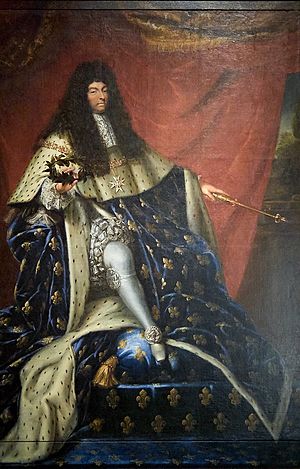
Louis decided to persecute Protestants and cancel the 1598 Edict of Nantes. This Edict had given Huguenots (French Protestants) religious freedom. Louis saw Protestantism as a sign of royal weakness. He wanted to unite France under one religion, Catholicism.
He started by excluding Protestants from government jobs. He closed their churches outside certain areas and banned Protestant preachers. He also encouraged Protestants to convert to Catholicism. Many Protestants did convert, especially among the nobles.
In 1681, Louis increased his persecution. He banned Protestants from leaving France. He also started quartering dragoons (soldiers) in Protestant homes. This caused great financial hardship and abuse. Many Huguenots converted to avoid these harsh measures.
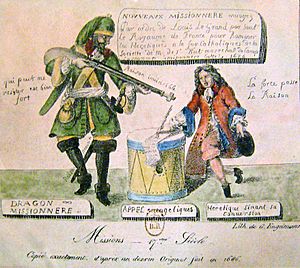
On 15 October 1685, Louis issued the Edict of Fontainebleau. This canceled the Edict of Nantes. It meant there would be no more Protestant groups, pastors, or churches in France. Existing churches were to be torn down. Pastors had to leave France or stop being ministers. Protestants who refused to convert were forced to be baptized as Catholics.
Historians have different ideas about why Louis did this. He might have wanted to please the Pope or gain prestige. He might also have wanted to end religious divisions in France.
Many historians believe the Edict of Fontainebleau harmed France. About 200,000 skilled Huguenots left France. They went to Protestant countries, which weakened the French economy and helped other nations. However, some historians argue that most important Protestant businessmen stayed and converted.
The reaction to the Edict was mixed. Catholic leaders in France were happy. But Protestants across Europe were horrified. Louis's image in Protestant countries suffered greatly.
Despite this, Louis may have helped prevent future religious conflicts in France. Later, in 1787, the Edict of Versailles (also called the Edict of Tolerance) restored civil rights to non-Catholics. With the French Revolution in 1789, Protestants gained equal rights.
The Nine Years' War
Causes and Fighting
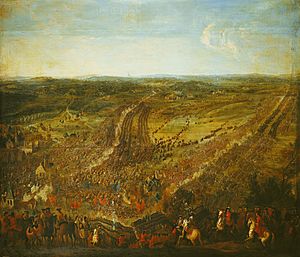
The Nine Years' War (1688–1697) marked a tougher period for Louis. It started because of two events in the Rhineland. First, the Elector Palatine died in 1685. Louis's sister-in-law had a claim to some family property. Louis pressed her claims. Second, the Archbishop of Cologne, a French ally, died in 1688. Louis wanted to install his own candidate as archbishop.
Louis's actions in the 1680s were seen as aggressive. This led to the formation of the League of Augsburg in 1686. This alliance included the Holy Roman Emperor, Spain, Sweden, and other German states. They wanted to push France back to its earlier borders.
Another important event was England's Glorious Revolution in 1688. King James II was Catholic. When his son was born, it seemed England would have Catholic kings. Protestant lords asked the Dutch Prince William III of Orange to help. William sailed to England, and James II fled. William (now William III of England) was strongly anti-French. He brought England into the war, turning the League of Augsburg into the Grand Alliance.
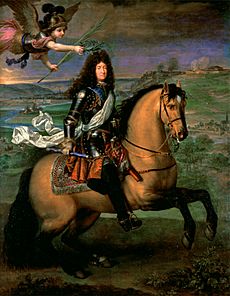
French armies generally won battles during the war. This was because the Holy Roman Emperor was busy fighting in the Balkans. France also had better supplies and skilled generals like Luxembourg. He won battles at Fleurus (1690), Steenkerque (1692), and Landen (1693). However, these victories didn't change the overall war much.
Louis personally oversaw the capture of Mons in 1691 and Namur in 1692. France also took over most of the Duchy of Savoy.
In July 1695, the Allies besieged Namur, which France held. Louis ordered the bombing of Brussels to distract them. More than 4,000 buildings were destroyed. But the strategy failed, and Namur fell. This damaged Louis XIV's reputation.
Peace talks began in 1690. By 1692, both sides wanted peace. But talks failed until 1696, when Savoy changed sides. Then, other members of the Grand Alliance rushed to the peace table. Negotiations led to the Peace of Ryswick in 1697.
The Peace of Ryswick
The Peace of Ryswick ended the Nine Years' War. Louis managed to divide his enemies.
France gained many benefits. Louis secured permanent French control over Alsace, including Strasbourg. The Rhine River became the border between France and Germany. France also got back its colonies in Pondichéry and Acadia. Louis's control of Saint-Domingue was recognized. However, he returned Catalonia and most of the other lands he had taken.
Louis was generous to Spain, which may have encouraged Spain's King Charles II to name Louis's grandson as his heir. France gave up its claims in Cologne and the Palatinate for money. Lorraine was returned to its Duke. William and Mary were recognized as rulers of Britain. The Dutch were allowed to put soldiers in forts in the Spanish Netherlands to protect against French attacks.
Even though Louis didn't get everything he wanted, the peace was good for France. France was tired from the war's costs.
The War of the Spanish Succession
Why the War Started
The question of who would inherit the Spanish throne had worried European leaders for over 40 years. King Charles II ruled a huge empire, but he had no children.
The main people who could claim the throne were from the French and Austrian royal families. The French claim came from Louis XIV's mother and wife, who were both Spanish princesses. The Austrian claim came from Emperor Leopold I's son, Archduke Charles.
To avoid war, Louis signed a treaty with William III of England in 1698. This agreement divided Spain's territories. But Charles II of Spain did not want his empire broken up. He named Joseph Ferdinand of Bavaria, a grandson of Leopold I, as his only heir.
Six months later, Joseph Ferdinand died. So, in 1700, Louis and William III made a new agreement. This gave Spain and its colonies to Archduke Charles. Louis's son would get Spain's Italian lands. But Charles II, under pressure, changed his will again. He named Archduke Charles as his only heir.
Accepting the Will and Its Results
On his deathbed in 1700, Charles II of Spain changed his will one last time. He offered his entire empire to Louis XIV's grandson, Philip, Duke of Anjou. This was on the condition that the empire remained whole. Philip was not in the direct line to the French throne, so this would not unite France and Spain.
Louis faced a tough choice. He could agree to divide Spain's lands and avoid war. Or he could accept Charles II's will and upset most of Europe. Louis's foreign minister pointed out that war with the Emperor would likely happen either way. So, Louis decided to accept Charles II's will. Philip, Duke of Anjou, became Philip V, King of Spain.
Most European rulers accepted Philip as king, though some were hesitant. Louis confirmed that Philip V could still claim his French rights. This made other countries nervous. Louis also sent troops to the Spanish Netherlands. In 1701, Philip gave France the right to supply slaves to Spanish colonies.
As tensions grew, Louis recognized James Stuart, the son of James II, as the rightful king of England. This angered William III. Britain and the Dutch Republic, along with the Holy Roman Emperor, formed another Grand Alliance. They declared war on France in 1702. France gained Bavaria, Portugal, and Savoy as allies.
The War Begins
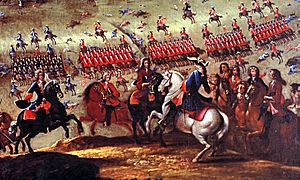

The War of the Spanish Succession started even before it was officially declared. It lasted almost until Louis's death and cost France a lot.
France had some early successes. But talented generals like Marlborough and Eugene of Savoy stopped them. They defeated the French at the Battle of Blenheim. This victory led Portugal and Savoy to join the Allies. Later, the Battle of Ramillies gave the Low Countries to the Allies. The Battle of Turin forced Louis to leave Italy.
France suffered from defeats, famine, and growing debt. Between 1693 and 1710, over two million people died from two famines. Louis was so desperate that by 1708–09, he was ready to make peace at almost any cost. He agreed that the Spanish empire should go to Archduke Charles. He also agreed to return to France's borders from 60 years earlier. But he couldn't force Philip V to accept these terms. The Allies demanded that Louis attack his own grandson to make him agree. Louis could not accept this.
The War's Turning Point
Towards the end of the war, it became clear that neither side could completely win. The Allies were driven out of central Spain by Franco-Spanish victories in 1710. French forces remained strong despite their earlier defeats. The Allies had a very costly victory at the Battle of Malplaquet, with twice as many casualties as the French. France regained its military pride with a big victory at Denain in 1712.
The political situation in Austria also changed. Emperor Leopold I died in 1705, and his son Joseph I died in 1711. Archduke Charles became the new Holy Roman Emperor. If he also got the Spanish empire, it would create a huge empire like in the 16th century. Britain and the Dutch Republic did not want this, just as they didn't want France and Spain to unite.
Making Peace
Because of Britain's new view on the balance of power, talks began between Britain and France. This led to the Peace of Utrecht in 1713. In 1714, the Holy Roman Emperor also made peace with France.
In the peace agreement, Philip V kept Spain and its colonies. Austria received the Spanish Netherlands and parts of Italy. Britain kept Gibraltar and Menorca. Louis agreed to stop supporting James Stuart, the pretender to the British throne. He also gave up Newfoundland, Rupert's Land, and Acadia in the Americas to Britain.
Britain gained the most from the treaty. But the final terms were much better for France than what was discussed earlier. France kept Île-Saint-Jean and Île Royale. Louis also gained some small European territories. His allies, the Electors of Bavaria and Cologne, got their lands back.
Louis XIV's Personal Life
Family and Marriages
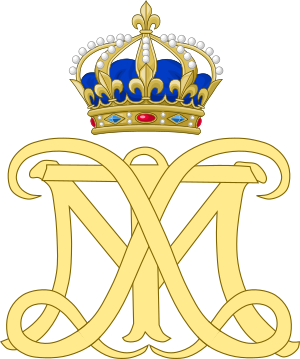
Louis and his first wife, Maria Theresa of Spain, had six children. However, only their oldest son, Louis, le Grand Dauphin, lived to be an adult. Maria Theresa died in 1683. Louis said she had never caused him any trouble.
Louis was not always faithful to Maria Theresa. He had several children outside of his marriage. He later recognized some of these children.
Louis was more faithful to his second wife, Françoise d'Aubigné, Marquise de Maintenon. He met her when she was caring for his children. He was at first put off by her strong religious beliefs. But he grew to like her because of her care for his children.
They are believed to have married secretly around October 1683 or January 1684. This marriage was not announced publicly, but it was an open secret. It lasted until Louis's death.
Beliefs and Religion
Louis was a very religious king. He saw himself as the leader and protector of the Catholic Church in France. He prayed every day. Under the influence of his second wife, he became even more devoted to his Catholic faith. He even banned opera and comedy during Lent.
His religious ceremonies were often grand. Louis started the Paris Foreign Missions Society to encourage Catholic missions.
Supporting the Arts
Louis was a generous supporter of the arts. He became the "Protector" of the Académie Française, a famous French language and literature institution. He helped French literature flourish by supporting writers like Molière, Racine, and La Fontaine. Their works are still famous today.
Louis also supported visual artists like Charles Le Brun and Hyacinthe Rigaud. Their works became known across Europe. Composers and musicians like Jean-Baptiste Lully also thrived. In 1661, Louis founded the Académie Royale de Danse (Royal Academy of Dance). In 1669, he founded the Académie d'Opéra. These were important for the development of ballet.
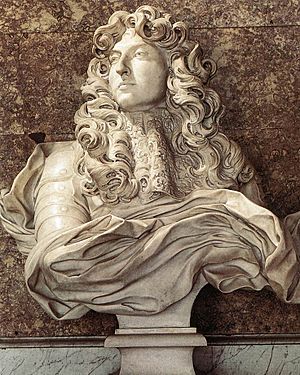
Louis transformed a hunting lodge built by his father into the amazing Palace of Versailles. The palace became the royal court's official home on 6 May 1682. Versailles was a stunning place for state events and receiving foreign visitors. At Versailles, the King was always the center of attention.
Some people think Louis built Versailles because he hated Paris after the Fronde rebellion. But he also supported many public works in Paris, like a police force and street lighting. He built the Hôtel des Invalides, a home for injured or old soldiers. This place set new standards for care. Louis also had Paris's northern walls torn down in 1670 and replaced with wide, tree-lined streets.
Louis also improved the Louvre and other royal homes. He hired famous artists like Gian Lorenzo Bernini to work on them.
How Louis XIV Was Seen
Royal Portraits and Image
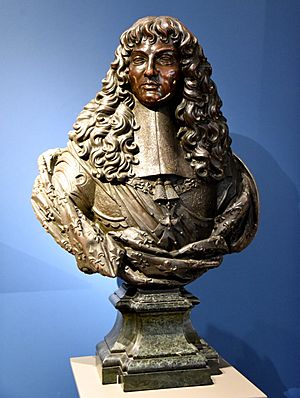
Louis XIV wanted to be remembered in a grand way. He created his image as the Sun King, the center of the universe. He used court rituals and art to show his power over France.
His portraits often showed him as a Roman emperor, the god Apollo, or Alexander the Great. These images focused on showing him as a powerful figure, not just a realistic person. A famous example is Hyacinthe Rigaud's Portrait of Louis XIV from 1701. It shows a 63-year-old Louis with very young-looking legs.
Rigaud's portrait was meant to glorify the monarchy. Louis liked it so much that he kept the original and had a copy sent to his grandson, Philip V of Spain. This portrait became a model for future French royal portraits. It showed Louis's high status through his pose, royal clothes, and the grand setting.
Other Art Forms
Louis ordered at least 20 statues of himself in the 1680s. These were placed in Paris and other towns to show his rule. He also hired "war artists" to record his military victories. To remind people of these triumphs, Louis built permanent triumphal arches.
His reign also saw the rise of medallions. Louis had over 300 medals made to celebrate events in his reign. These were spread throughout France.
He also used tapestries to praise the monarchy. Tapestries showed allegories, royal homes, or historical events. They were an important way to spread royal messages before the Hall of Mirrors was built at Versailles.
Louis XIV and Ballet
Louis loved ballet and often danced in court ballets. He performed 80 roles in 40 major ballets, almost like a professional dancer.
He chose roles that showed him as royal or godlike, like Neptune or Apollo. Sometimes he would start in a small role and then appear as the main character. He always performed with great majesty. For Louis, ballet was not just propaganda. He had a deep interest in the art form.
Louis also used ballet as a political tool. He made it a big part of court life. This kept his nobles focused on dancing standards, distracting them from political activities. In 1661, he founded the Académie Royale de Danse (Royal Academy of Dance). He also ordered his dance instructor, Pierre Beauchamp, to create a notation system to record ballet. This helped spread French culture and ballet across Europe.
Louis emphasized strict rules for ballet dancing. The "La belle danse" (French noble style) required challenging skills. Its movements mimicked court behaviors, reminding nobles of the King's absolute power.
Health and Death of Louis XIV

Even though Louis tried to appear healthy, he had many health problems. He had symptoms of diabetes, dental issues, boils, fainting spells, and headaches. His doctors kept daily records of his health.
Louis died of gangrene at Versailles on 1 September 1715, just before his 77th birthday. He had ruled for 72 years. He was in great pain but died peacefully, like "a candle going out." His body was buried in Saint-Denis Basilica near Paris.
Who Came Next?
Louis outlived most of his direct family. His last surviving legitimate son, the Dauphin, died in 1711. A year later, the Duke of Burgundy, the Dauphin's oldest son and Louis's heir, also died. Burgundy's older son died a few weeks later. So, when Louis died, his heir was his five-year-old great-grandson, Louis, Duke of Anjou.
Louis knew his successor would be a child. He tried to limit the power of his nephew, Philip II, Duke of Orléans. Philip was Louis's closest living relative in France and would likely become regent. Louis created a regency council, giving some power to his illegitimate son. However, after Louis's death, Orléans had the will canceled and made himself the sole regent.
Line of Succession in 1715
Here is the line of succession to the French throne when Louis XIV died in 1715. His only surviving legitimate grandson, Philip V of Spain, was not included because he had given up his claim to the French throne after the War of the Spanish Succession.
 Louis XIII (1601–1643)
Louis XIII (1601–1643)
 Louis XIV (1638–1715)
Louis XIV (1638–1715)
- Louis, Grand Dauphin (1661–1711)
- Louis, Duke of Burgundy (1682–1712)
- Louis, Grand Dauphin (1661–1711)
* Louis, Duke of Brittany (1707–1712)
*- (1) Louis, Duke of Anjou (1710–1774)
-
-
-
- Philip V of Spain (1683–1746)
- Charles, Duke of Berry (1686–1714)
-
- Philippe I, Duke of Orléans (1640–1701)
- (2) Philippe II, Duke of Orléans (1674–1723)
- (3) Louis, Duke of Chartres (1703–1752)
- (2) Philippe II, Duke of Orléans (1674–1723)
-
-
Louis XIV's Legacy
His Reputation and Impact
Some historians say that Louis's achievements were great. They point to his military and diplomatic successes, like putting a French prince on the Spanish throne. This, they argue, ended the threat of Spain interfering in French politics. They also highlight how his wars expanded France's borders, protecting it from invasion until the French Revolution.
Louis also helped his people by supporting the arts, encouraging industry and trade, and starting an overseas empire. The big reduction in civil wars and noble rebellions during his reign is seen as a result of Louis making the King's power stronger. His early reforms helped create the modern French state. His victories and cultural achievements made France a leading power in Europe. Other European countries started to copy French manners, values, and goods. French became the main language of the European elite.
Critics of Louis say that his huge spending on foreign wars and his military made France poor. However, his supporters argue that the state was poor, but France itself was not.
Some critics also say that Louis failed to reform French institutions, which led to the French Revolution later. But others argue that the institutions worked well under him. They also say that Louis could not have predicted events 80 years after his death.
Louis has often been criticized for being vain. The philosopher Voltaire thought Louis's vanity caused his love for war.
However, Louis has also received praise. Napoleon called him "a great king" and "the only King of France worthy of the name." The German philosopher Leibniz called him "one of the greatest kings that ever was." Voltaire's book, The Age of Louis XIV, called Louis's reign one of the four great ages of reason and culture, and the greatest ever.
Famous Quotes Attributed to Louis XIV
Many famous quotes are linked to Louis XIV.
The well-known phrase "I am the state" ("L'état, c'est moi.") was reported later, but historians debate if he actually said it.
He did say, "Every time I appoint someone to a vacant position, I make a hundred unhappy and one ungrateful." Louis is also recorded as saying on his deathbed: "Je m'en vais, mais l'État demeurera toujours." ("I depart, but the State shall always remain.")
Royal Symbols
 |
|
Order of Saint Louis
On 5 April 1693, Louis also founded the Royal and Military Order of Saint Louis. He named it after Louis IX. It was a military award for outstanding officers. It was special because it was the first award that could be given to non-nobles. It is similar to the later Légion d'honneur.
Family
Issue
| Name | Birth | Death | Notes |
|---|---|---|---|
| By Maria Theresa, Queen of France | |||
| Louis, le Grand Dauphin | 1 November 1661 | 14 April 1711 | Son of France. Dauphin of France (1661–1711). Had children. Father of Louis, Dauphin of France, Philip V of Spain and Charles, Duke of Berry. Grandfather of Louis XV of France. |
| Anne Élisabeth | 18 November 1662 | 30 December 1662 | Daughter of France. Died as a baby. |
| Marie Anne | 16 November 1664 | 26 December 1664 | Daughter of France. Died as a baby. |
| Marie Thérèse | 2 January 1667 | 1 March 1672 | Daughter of France. Known as Madame Royale. Died as a child. |
| Philippe Charles, Duke of Anjou | 5 August 1668 | 10 July 1671 | Son of France. Died as a child. |
| Louis François, Duke of Anjou | 14 June 1672 | 4 November 1672 | Son of France. Died as a baby. |
Louis XIV also had several children outside of his marriage, some of whom he officially recognized.
| Name | Birth | Death | Notes |
|---|---|---|---|
| By Louise de La Vallière | |||
| Marie Anne de Bourbon | 2 October 1666 | 3 May 1739 | Officially recognized on 14 May 1667. Married Louis Armand I, Prince of Conti. |
| Louis, Count of Vermandois | 3 October 1667 | 18 November 1683 | Officially recognized on 20 February 1669. |
| By Françoise-Athénaïs, marquise de Montespan | |||
| Louis Auguste, Duke of Maine | 31 March 1670 | 14 May 1736 | Officially recognized on 20 December 1673. Held many important jobs. Had children. |
| Louis César, Count of Vexin | 20 June 1672 | 10 January 1683 | Officially recognized on 20 December 1673. |
| Louise Françoise de Bourbon | 1 June 1673 | 16 June 1743 | Officially recognized on 20 December 1673. Married Louis III, Prince of Condé. Had children. |
| Louise Marie Anne de Bourbon | 12 November 1674 | 15 September 1681 | Officially recognized in January 1676. |
| Françoise Marie de Bourbon | 9 February 1677 | 1 February 1749 | Officially recognized in November 1681. Married Philippe II, Duke of Orléans, who was the Regent of France for Louis XV. Had children. |
| Louis Alexandre, Count of Toulouse | 6 June 1678 | 1 December 1737 | Officially recognized on 22 November 1681. Held many important jobs. Had children. |
Images for kids
See also
 In Spanish: Luis XIV de Francia para niños
In Spanish: Luis XIV de Francia para niños


